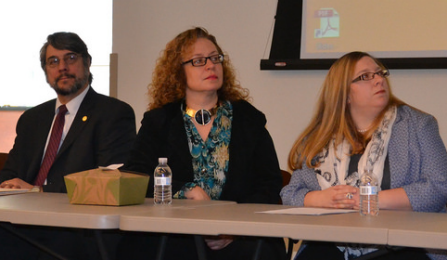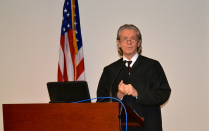Vital help for do-it-yourself litigants

Robert Elardo of ECBA Volunteer Lawyers Project, Vice Dean for Legal Skills Kim Diana Connolly and Lecturer in Law Bernadette Gargano participate in a Pro Se Training event organized by the Law School and the Erie County Bar Association’s Volunteer Lawyers Project.
Helping to address a critical gap in access to justice, a new practicum is putting SUNY Buffalo Law students to work at Erie County Family Court and Buffalo’s federal District Court. They are there not to give legal advice, but to help civil litigants who wish to defend themselves navigate the unfamiliar court system.
The school’s Pro Se Civil Litigation Practicum, new this semester, exposes students to these two key courts, where they work with pro se clients under the supervision of a volunteer attorney. The six second- and third-year students enrolled this semester conduct intake of new clients, recording information on their case and preparing them to meet with the attorney. The student then accompanies the client to meet with the volunteer attorney, who provides limited-scope representation in advising the litigant about the pro se process.
Law School faculty member Bernadette Gargano – who co-teaches the practicum with Bridget O’Connell, a mediator for the 8th Judicial District – says the arrangement is designed to expose students to a variety of court settings and clients, while also meeting a critical need in helping pro se clients find their way in the court system.
“For these litigants it’s very important,” Gargano says. “Coming in as a layperson and trying to figure out complex legal issues, such as: what does an interrogatory mean; what is a deposition; how can I get information from the opposing party; what is the difference between a motion to dismiss and a motion for summary judgment, etc. – all of this is foreign to them.”
Designed for the many litigants in these courts who lack the means to hire an attorney, but are involved in cases hugely important in their lives. In Family Court that can mean custody hearings, child support cases and divorce proceedings; in federal court, cases might range from employment discrimination to civil rights complaints, certain immigration issues and Social Security disability appeals.
“It really is about providing equal access to everybody, consistent with the 14th Amendment,” Gargano says. “We’re making sure that the students have this perspective so that, even if they go to a big firm, they’ll remember that pro bono service is an important part of the profession.”
The Western New York legal community, including Legal Aid and Neighborhood Legal Services, has stepped up to provide pro bono representation in some cases in these courts, but, says Gargano, “we still have this huge shortfall.” The Law School is partnering with the Erie County Bar Association’s Volunteer Lawyers Project for this initiative, and on Jan. 17 conducted a CLE to train more potential volunteers who want to help pro se clients.
In addition to their court duties, students in the practicum are also working on community education projects, such as preparing pamphlets that can answer basic questions for pro se litigants. Students also gather weekly for a substantive class that requires a final academic paper on an access-to-justice issue.
Says Professor Kim Diana Connolly, the Law School’s vice dean for legal skills and director of clinical education, “Many good law schools around the country have had classes or clinics that dealt with pro se matters, and we have sought assistance from people around the country in modeling our program. What makes ours unique is that we are combining pro se work in both Family Court and federal court, which will allow the classroom component to focus on deeper access-to-justice issues.
“There are so many people and families in real need. Although our law school does not have capacity to litigate these cases for them, through our students, faculty, and the help of lawyers in the community, we can certainly help them do a better job representing themselves and help the courts manage these cases more efficiently.”
